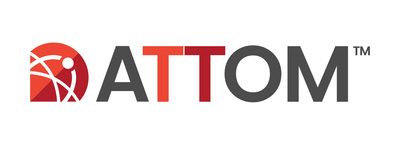Residential Loans Down Another 7 Percent, to Smallest Level Since 2000; Total Lending Activity Off Almost 70 Percent in Three Years; Purchase, Refinance and Home-Equity Lending All Decrease
IRVINE, Calif., June 6, 2024 /PRNewswire/ — ATTOM, a leading curator of land, property, and real estate data, today released its first-quarter 2024 U.S. Residential Property Mortgage Origination Report, which shows that 1.28 million mortgages secured by residential property (1 to 4 units) were issued in the United States during the first quarter, representing a 6.8 percent decline from the previous quarter. The drop-off marked the 11th in the last 12 quarters, to the lowest level since 2000.
The latest decline left total residential lending activity down 4.8 percent from a year earlier and 69.3 percent from a high point hit in 2021. It came amid another period of rising mortgage interest rates and elevated home prices unaffordable to significant portions of American households, on top of low supplies of homes for sale.
Ongoing decreases in lending activity during the first quarter resulted from losses in all major categories of residential lending. Purchase-loan activity went down another 9.9 percent quarterly, to about 565,000, while refinance deals dipped downward by 1.9 percent, to 491,000. Home-equity credit lines slipped 9 percent, to 222,000.
Measured monetarily, lenders issued $405.6 billion worth of residential mortgages in the first quarter of 2024. That was down 4.8 percent from the fourth quarter of 2023 and 4.5 percent from the first quarter of last year.
The varying paces of change among different loan types helped reduce the portion of all residential mortgages represented by purchase lending for the third straight quarter while pushing the refinance component upward. Still, purchase loans were the most common form of mortgages around the U.S. in early 2024, comprising more than 40 percent, followed by refinance packages and home-equity lending.
“There is reason to hope that we will see something of a turnaround when second-quarter data comes in, given the jump in lending activity that happened during the peak home-buying season of 2023,” said Rob Barber, CEO at ATTOM. “But with little sign that interest rates are coming down, which could fire up refinance and HELOC lending, or that supplies of homes for sale are going up, any increase is likely to be limited.”
Home-mortgage lending took another hit in the early months of 2024 as average interest rates for 30-year fixed loans rose close to 7 percent (it has since increased). That continued to push up home ownership costs at a time when near-record home prices in most of the country already were unaffordable, or a significant financial stretch, for average wage earners. Purchase lending was further eroded amid counts of homes for sale that were less than half the levels seen five years ago.
Total lending activity down in two-thirds of nation
Banks and other lenders issued a total of 1,277,899 residential mortgages in the first quarter of 2024, down from 1,371,344 in the fourth quarter of 2023. The fallback continued a three-year run of declines that was broken only by a spike in the second quarter of last year.
The latest total also was down annually from 1,343,010 in the first quarter of 2023, and from a recent high point of 4,165,204 hit in the first quarter of 2021.
A total of $405.6 billion was lent to homeowners and buyers in the first quarter of this year, which was down from $426.1 billion in the prior quarter and down from $424.6 billion in the first quarter of 2023. The latest figure stood at less than one-third of the recent peak of $1.29 trillion hit in 2021.
Overall lending activity dipped lower from the fourth quarter of last year to the first quarter of this year in 125, or 69 percent, of the 182 metropolitan statistical areas around the U.S. that had a population of 200,000 or more and at least 1,000 total residential mortgages issued in the first quarter of 2024.
Total lending also remained down from the first quarter of 2023 in 118, or 65 percent, of the metro areas analyzed. It was off by at least 5 percent annually in almost half of those markets.
The largest quarterly decreases were in St. Louis, MO (total lending down 40.5 percent from the fourth quarter of 2023 to the first quarter of 2024); Buffalo, NY (down 29.9 percent); Albany, NY (down 28.6 percent); Syracuse, NY (down 27.4 percent) and Pensacola, FL (down 25.6 percent).
Aside from St. Louis and Buffalo, metro areas with a population of least 1 million that had the biggest decreases in total loans from the fourth quarter of 2023 to the first quarter of 2024 were Minneapolis, MN (down 21.2 percent); Hartford, CT (down 18.2 percent) and Honolulu, HI (down 16.3 percent).
The biggest quarterly increases among metro areas with a population of at least 1 million came in Tucson, AZ (total lending up 15.2 percent from the fourth quarter of 2023 to the first quarter of 2024); Phoenix, AZ (up 14.9 percent); Birmingham, AL (up 8.8 percent); Virginia Beach, VA (up 8.6 percent) and Memphis, TN (up 8.3 percent).
Purchase mortgages slump throughout U.S. but remain top loan type
Loans issued to home buyers fell back in the first few months of 2024 for the third straight quarter after a surge of about 25 percent in the Spring of last year.
The latest total of 564,598 dropped from 626,759 in the fourth quarter of 2023. It was also down 12.3 percent from 643,988 a year earlier and almost two-thirds from a high point of 1,516,377 hit in the Spring of 2021.
The $214.8 billion dollar volume of purchase loans in the first quarter of 2024 was down 6.7 percent from $230.2 billion in the fourth quarter of 2023 and 7.8 percent from $233.1 billion in the first quarter of last year.
Residential purchase-mortgage originations decreased quarterly in 132 of the 182 metro areas in the report (73 percent) and annually in 77 percent of those markets.
The largest quarterly decreases were in Wichita, KS (purchase loans down 66.5 percent from the fourth quarter of 2023 to the first quarter of 2024); Mobile AL (down 54.2 percent); St. Louis, MO (down 45.3 percent); Manchester, NH (down 39 percent) and Buffalo, NY (down 38.3 percent).
Aside from St. Louis and Buffalo, the biggest quarterly decreases in metro areas with a population of at least 1 million in the first quarter of 2024 came in Boston, MA (down 27.6 percent); Minneapolis, MN (down 24.8 percent) and Milwaukee, WI (down 24.5 percent).
The top increases in purchase lending from the fourth quarter of 2023 to the first quarter of 2024 in metro areas with a population of at least 1 million were in Phoenix, AZ (up 23.6 percent); Tucson, AZ (up 23.6 percent); Orlando, FL (up 18.6 percent); Las Vegas, NV (up 18 percent) and Tampa, FL (up 13.2 percent).
Refinance mortgages still up year over year but remain far beneath peak
Lenders issued 490,953 residential refinance mortgages in the first quarter of 2024. That was down from 500,323 in the fourth quarter of 2023, although still up 11.4 percent from 440,890 a year earlier because of a short-lived jump in 2023.
Nevertheless, the latest figure remained down 82.1 percent from a peak of 2,742,371 in early 2021 when mortgage rates below 3 percent sent refinance deals soaring.
The $149.6 billion dollar volume of refinance packages in the first quarter of 2024 was down 1.2 percent from $151.4 billion in the prior quarter, but still 4.7 percent higher than $142.9 billion in the first quarter of 2023.
Refinancing activity went down quarterly in 83, or 46 percent, of the 182 metro areas around the U.S. with enough data to analyze. It was up annually in 149, or 82 percent, of those metros.
The largest quarterly decreases were in St. Louis, MO (refinance loans down 35 percent from the fourth quarter of 2023 to the first quarter of 2024); Green Bay, WI (down 30.1 percent); Madison, WI (down 26.9 percent); Honolulu, HI (down 25.5 percent) and Scranton, PA (down 23.9 percent).
Aside from St. Louis and Honolulu, metro areas with a population of least 1 million where refinance activity decreased most quarterly were Atlanta, GA (down 19.6 percent); Buffalo, NY (down 18.9 percent) and Minneapolis, MN (down 14.7 percent).
Metro areas with a population of least 1 million and the largest increases in the number of refinance loans from the fourth quarter of 2023 to the first quarter of 2024 were Virginia Beach, VA (up 26.7 percent); Memphis, TN (up 26.5 percent); Birmingham, AL (up 23.5 percent); San Jose, CA (up 21.6 percent) and Seattle, WA (up 18.3 percent).
HELOC lending slips again, down in three-quarters of metro markets
Home-equity lines of credit (HELOCs) also decreased in the first quarter of 2024, declining to 222,348 from 244,262 in the fourth quarter of 2023. The latest count was down 13.9 percent from 258,132 a year earlier. The first-quarter decrease marked the third in a row after a brief gain last Spring.
The $41.1 billion volume of HELOC loans in the first quarter of 2024 was down from $44.5 billion in the prior three-month period, a 7.6 percent decline. The latest total also was down annually, by 15.5 percent.
HELOCs comprised 17.4 percent of all loans in the most recent quarter. That was down from 19.2 percent in the first quarter of 2023 but still almost four times the level recorded in the early part of 2021.
HELOC mortgage originations decreased from the fourth quarter of 2023 to the first quarter of 2024 in 75 percent of the metro areas analyzed. The largest quarterly decreases in metro areas with a population of at least 1 million were in St. Louis, MO (down 37.4 percent from the fourth quarter of 2023 to the first quarter of 2024); Kansas City, MO (down 27.6 percent); Buffalo, NY (down 27.3 percent); Indianapolis, IN (down 24 percent) and Fresno, CA (down 22.6 percent).
The largest quarterly increases in HELOC activity in metro areas with a population of at least 1 million and sufficient data to analyze came in Columbus, OH (up 8.5 percent); Baltimore, MD (up 5.1 percent); New York, NY (up 3.4 percent); New Orleans, LA (up 1.7 percent) and Washington, DC (up 0.8 percent).
FHA and VA loan percentages rise
Mortgages backed by the Federal Housing Administration (FHA) rose early this year as a percentage of all lending. They accounted for 210,246, or 16.5 percent, of all residential property loans originated in the first quarter of 2024. That was up from 15.7 percent in the fourth quarter of 2023 and 12.9 percent in the first quarter of 2023.
Residential loans backed by the U.S. Department of Veterans Affairs (VA) totaled 68,430, or 5.4 percent, of all residential property loans originated in the first quarter of 2024. That was up from 4.3 percent in the previous quarter, although down slightly from 5.5 percent a year earlier.
Typical purchase loan goes up while down payments decline, both by unusually large amounts
As the national median home price increased in the first quarter of 2024, the typical single-family home loan also rose. But the opposite was true for median down-payment percentages.
Among homes purchased with financing in the first quarter of 2024, the median loan amount climbed to $329,800. That was up 7.4 percent from $307,000 in the prior quarter and 7.2 percent from $307,722 a year earlier. The quarterly increase was the largest since the second quarter of 2021.
However, the median down payment of $26,700 on single-family homes purchased with financing in the first quarter of 2024 dropped by 20.9 percent, from $33,750 in the fourth quarter of 2023. For the year, it was down 3.1.
Report methodology
ATTOM analyzed recorded mortgage and deed of trust data for single-family homes, condos, town homes and multi-family properties of two to four units for this report. Each recorded mortgage or deed of trust was counted as a separate loan origination. Dollar volume was calculated by multiplying the total number of loan originations by the average loan amount for those loan originations.
About ATTOM
ATTOM provides premium property data to power products that improve transparency, innovation, efficiency, and disruption in a data-driven economy. ATTOM multi-sources property tax, deed, mortgage, foreclosure, environmental risk, natural hazard, and neighborhood data for more than 155 million U.S. residential and commercial properties covering 99 percent of the nation’s population. A rigorous data management process involving more than 20 steps validates, standardizes, and enhances the real estate data collected by ATTOM, assigning each property record with a persistent, unique ID — the ATTOM ID. The 30TB ATTOM Data Warehouse fuels innovation in many industries including mortgage, real estate, insurance, marketing, government and more through flexible data delivery solutions that include ATTOM Cloud, bulk file licenses, property data APIs, real estate market trends, property navigator and more. Also, introducing our newest innovative solution, making property data more readily accessible and optimized for AI applications– AI-Ready Solutions.
Media Contact:
Megan Hunt
[email protected]
Data and Report Licensing:
[email protected]
![]() View original content to download multimedia:https://www.prnewswire.com/news-releases/us-home-mortgage-lending-declines-again-in-first-quarter-nearing-low-point-302165265.html
View original content to download multimedia:https://www.prnewswire.com/news-releases/us-home-mortgage-lending-declines-again-in-first-quarter-nearing-low-point-302165265.html
SOURCE ATTOM

Featured image: Deposit Photos © violetkaipa
















